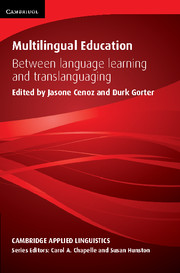Book contents
- Frontmatter
- Contents
- List of contributors
- Series editors’ preface
- Acknowledgements
- 1 Towards a holistic approach in the study of multilingual education
- 2 L1 as a pedagogical resource in building students’ L2 academic literacy: pedagogical innovation in the science classroom in a Hong Kong school
- 3 Linking content, linking students: a cross-linguistic pedagogical intervention
- 4 The role of the native language in the literacy development of Latino students in the United States
- 5 A nexus analysis of code choice during study abroad, and implications for language pedagogy
- 6 Multilingual practices in foreign language study
- 7 Language choices and ideologies in the bilingual classroom
- 8 Communicative repertoires in the community language classroom: resources for negotiating authenticity
- 9 Complementary classrooms for multilingual minority ethnic children as a translanguaging space
- 10 Constructing in-between spaces to ‘do’ bilingualism: a tale of two high schools in one city
- 11 Becoming multilingual and being multilingual: some thoughts
- Index
Series editors’ preface
Published online by Cambridge University Press: 17 September 2021
- Frontmatter
- Contents
- List of contributors
- Series editors’ preface
- Acknowledgements
- 1 Towards a holistic approach in the study of multilingual education
- 2 L1 as a pedagogical resource in building students’ L2 academic literacy: pedagogical innovation in the science classroom in a Hong Kong school
- 3 Linking content, linking students: a cross-linguistic pedagogical intervention
- 4 The role of the native language in the literacy development of Latino students in the United States
- 5 A nexus analysis of code choice during study abroad, and implications for language pedagogy
- 6 Multilingual practices in foreign language study
- 7 Language choices and ideologies in the bilingual classroom
- 8 Communicative repertoires in the community language classroom: resources for negotiating authenticity
- 9 Complementary classrooms for multilingual minority ethnic children as a translanguaging space
- 10 Constructing in-between spaces to ‘do’ bilingualism: a tale of two high schools in one city
- 11 Becoming multilingual and being multilingual: some thoughts
- Index
Summary
The title of this volume, Multilingual Education: Between language learning and translanguaging, reflects its focus on an area of study in transition. As the first chapter explains, the study of multilingualism in educational contexts has taken on a new character and significance in the current era because of globalization. Never before has the world experienced such dramatic levels of language contact, which results in the need for people to use a language other than their own to learn, make friends and conduct business. The editors point out that this situation, which has arisen because of the growth in connections among people that has been made possible through increased mobility and technology, requires new perspectives for applied linguists to study meaningfully the acquisition and use of more than one language in contexts where multiple languages are in use.
The editors define multilingualism as the use of languages that are not originally from nearby geographical areas. Multilingualism can be studied both as a social phenomenon and at the individual level. The former perspective investigates who uses what language for what purposes. In other words, research on societal multilingualism stems from a sociolinguistic orientation to the study of language use. The study of individual multilingualism intersects with research on language acquisition, including an individual's choice of language in social use as well. The study of multilingualism as reported in the 11 chapters of the volume demonstrates the intersection of the social and individual perspectives as multilingualism is taught and enacted in educational settings around the world.
The global dimensions of multilingual education are evident in the range of languages that appear in the research on various multilingual configurations: Chinese–English in Hong Kong and the UK, English– French in Canada, English–German in the USA and Germany, English– Panjabi in the UK and Spanish–English in the USA. In each of the contexts under investigation, the goal of multilingual education is for students to develop, use and value more than one language. Multilingual education as defined in this volume rejects the educational goals of transitioning students towards monolingualism, for example the use of the home language as a temporary stepping stone to help students while they learn to function in the majority language.
- Type
- Chapter
- Information
- Multilingual EducationBetween Language Learning and Translanguaging, pp. xiv - xvPublisher: Cambridge University PressPrint publication year: 2015
- 1
- Cited by



